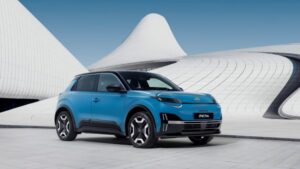Peugeot’s E-Boxer represents the electric version of the company’s largest commercial van, sharing its DNA with the Stellantis family that includes the Citroen e-Relay, Fiat E-Ducato, and Vauxhall Movano Electric. The platform prioritizes payload capacity and workspace for businesses focused on cargo volume and cost efficiency.
After 19 years wearing various badges, this van received a much-needed facelift. However, it faces strong competition from the Renault Master E-Tech, which has earned widespread praise from industry experts.
Design and Interior Features
The E-Boxer maintains the familiar profile of its diesel counterpart. Only subtle electric badging and the absence of an exhaust pipe reveal its powertrain. The design emphasizes function over aesthetics – its boxy shape maximizes cargo space.
The dashboard layout remains practical and straightforward. Standard equipment includes a seven-inch digital instrument cluster and matching touchscreen infotainment system with Apple CarPlay and Android Auto connectivity. An upgraded 10-inch navigation screen costs an additional £800.
Material quality meets commercial vehicle standards with durable plastics and simple controls. Electric variants include automatic climate control, electronic parking brake, and comprehensive driver assistance systems – advanced emergency braking, traffic sign recognition, lane support, and drowsiness detection.
The cabin shows its age through details like an awkwardly positioned cupholder system mounted low where a middle passenger’s feet would rest.
Electric Powertrain and Performance
A 110kWh battery pack powers a single electric motor producing 275bhp and 302lb ft of torque. This makes the E-Boxer among the most powerful large electric vans available, though real-world acceleration remains modest given its size and weight.
WLTP range spans 235 to 263 miles depending on configuration and body style.
Real-world range typically falls between 180-200 miles based on payload, driving conditions, and temperature. The van supports up to 150kW DC fast charging, reaching 5% to 80% capacity in under an hour. A three-phase 22kW AC charger completes a full charge in just over six hours, while a standard 7.4kW home wallbox requires approximately 17 hours.
The electric drivetrain delivers smooth, quiet operation with strong low-speed response. Engineers tuned the system for payload capacity rather than performance, but immediate torque helps with loaded acceleration. Suspension feels firm compared to car-based vans and can feel bouncy on imperfect surfaces, though it settles down at motorway speeds.
Cargo Capacity and Practicality
Peugeot offers the E-Boxer in two lengths – L3 and L4 – plus two roof heights, H2 and H3. Maximum cargo volume reaches 17 cubic meters, while payload capacity extends to 1,460kg depending on variant and gross vehicle weight selection.
Choosing the 3.5-tonne GVW limits payload to just 710kg – less than the compact Peugeot E-Partner.
The 4.25-tonne option increases payload but adds operational complexity. Businesses must navigate HGV regulations including Class 7 MOTs from year one, speed limiters, and tachograph requirements.
The boxy design wastes minimal space, and the low floor height aids loading. Standard features include twin rear doors opening to 180 degrees, side sliding door, six tie-down hooks, LED lighting, and configurable bulkhead options.
Battery placement doesn’t compromise cargo space compared to diesel versions. However, the electric drivetrain adds up to 700kg, reducing maximum payload capacity while remaining competitive within its class.
Pricing and Equipment
The E-Boxer starts at £49,485 plus VAT for the 3.5-tonne L3H2 configuration. Heavier 4.25-tonne variants command a modest premium but may not justify the additional regulatory burden for many operators.
Standard equipment includes the digital dashboard, touchscreen system, automatic climate control, safety systems, and LED daytime running lights. Option packages allow customization for fleet or specialized conversion needs.
Warranty coverage includes three years or 100,000 miles for the vehicle, plus an eight-year battery warranty extending to 100,000 miles with 70% capacity guarantee.
Market Position
The Peugeot E-Boxer offers competitive range, decent payload capacity, and practical body configurations. Factory conversion support adds appeal for specialized applications.
However, newer competitors have surpassed its capabilities. The Renault Master E-Tech – winner of the International Van of the Year award – delivers superior driving dynamics, comfort, payload capacity, and value.
After nearly two decades, this platform shows its age against more modern electric commercial vehicles. Stellantis faces pressure to develop a next-generation replacement to compete effectively in the evolving electric van market.
Specifications: Peugeot E-Boxer 40 L3H2 Panel Van
- Price: £50,295 plus VAT and OTR
- Powertrain: front-motor, front-wheel-drive
- Battery: 110 kWh
- Power: 275 bhp
- Torque: 302 lb ft
- Top speed: 56 mph (N2 van limited)
- Range: 263 miles
- Charging: up to 150 kW





